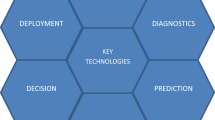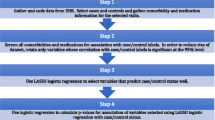Abstract
With escalating healthcare costs and increasing concerns about optimizing use of medicine, there is an unresolved debate over years around the potential impact of pharmaceutical promotion on physicians’ prescribing behaviors. What should be the appropriate balance of promotion dollars to physicians? We use three major brands in the US antibiotic universe to explore this issue, presenting a theoretical framework for better understanding the cause-and-effect relationship between common promotional spending and prescription responsiveness. Using simulations we demonstrate that neural networks guided by genetic algorithm-partial least squares is able to provide managers with better understanding of physicians’ prescribing activities without an appreciably lower predictive accuracy when compared to that obtained by a standalone neural network modeling.






Similar content being viewed by others
References
Liebman M (1997) Hard facts about a soft spend; how print advertising pays off. Med Mark Media 32(4):66–74
Westfall JM, McCabe J, Nicholas RA (1997) Personal use of drugs samples by physicians and office staff. J Am Med Assoc 278(2):141–143
Chew LD, O’ Young TS, Hazlet TK, Bradley KA, Maynard C, Lessler DS (2000) A physician survey of the effect of drug sample availability on physicians’ behavior. J Gen Intern Med 15(7):478–483
Rosenthal MB, Berndt ER, Donohue JM, Frank RG, Epstein AM (2002) Promotion of prescription drugs to consumers. N Engl J Med 346(7):498–505
Wolfe SM (2002) Direct-to-consumer advertising—education or emotion promotion? N Engl J Med 346(7):524–526
Ma J, Stafford RS, Cockburn IM, Finkelstein SN (2003) A statistical analysis of the magnitude and composition of drug promotion in the United States in 1998. Clin Ther 25(5):1503–1517
Rosenthal MB, Berndt ER, Donohue JM, Epstein AM, Frank RG (2003) Demand effects of recent changes in prescription drug promotion. Retrieved April 30, 2007 from The Henry J. Kaiser Family Foundation homepage
Füsun FG, Franklin C, Elina P, Kannan S (2001) Promotion of prescription drugs and its impact on physicians’ choice behavior. J Mark 65(7):79–90
Groves KEM, Sketris I, Tett SE (2003) Prescription drug samples—does this marketing strategy counteract for quality of medicines? J Clin Pharm Ther 28:259–271
Neslin S (2001) ROI analysis of pharmaceutical promotion (RAPP): an independent study. Retrieved April 30, 2007 from http://www.rxpromoroi.org/rapp/media/rapp_execsum.pdf
Wittink D (2002) Analysis of ROI for pharmaceutical promotion (ARPP): a second independent study. Retrieved April 30, 2007 from http://www.rxpromoroi.org/arpp/index.html
Lim CW, Kirikoshi T (2004) Prediction of promotional effect using neural network modeling. J Pharm Mark Manage 16(2):3–26
Lim CW, Kirikoshi T (2005) Predicting the effects of physician-directed promotion on prescription yield and sales uptake using neural networks. J Target Meas Anal Mark 13(2):156–167
Corstjens M, Merrihue J (2003) Optimal marketing. Harvard Bus Rev 10:114–121
Dieterle F, Busche S, Gauglitz G (2004) Different approaches to multivariate calibration of nonlinear sensor data. Anal Bioanal Chem 380:383–396
Jefferson MF, Pendleton N, Mohamed S, Kirkman E, Little RA, Lucas SB, Horan MA (1998) Prediction of hemorrhagic blood loss with a genetic algorithm neural network. J Appl Physiol 84:357–361
Gestal M, Gómez-Carracedo MP, Andrade JM, Dorado J, Fernández E, Prada D, Pazos A (2005) Selection of variables by genetic algorithms to classify apple beverages by artificial neural networks. Appl Artif Intell 19:181–198
Vellido A, Lisboa PJG, Vaughan J (1999) Neural networks in business: a survey of applications (1992–1998). Expert Syst Appl 17:51–70
Wong BK, Lai VS, Lam J (2000) A bibliography of neural network business applications research: 1994–1998. Comput Oper Res 27:1045–1076
Jones G (1998) Genetic and evolutionary algorithms. In: Schleyer PvR (eds) Encyclopedia of computational chemistry. Wiley, New York, pp 1127–1136
Martens H, Naes T (eds) (1989) Multivariate calibration. Wiley, New York
Esbensen KH (ed) (2001) Multivariate data analysis—in practice, 5th edn. Camo Process AS, Norway
Martens H, Martens M (eds) (2000) Multivariate analysis of quality—an introduction. Wiley, New York
Geladi P, Kowalski BR (1986) Partial least-squares regression: a tutorial. Anal Chim Acta 185:1–17
Akaike H (1973) Information theory and an extension of the maximum likelihood principle. In: Petrov BN, Csaki F (eds) Proceeding 2nd International Symposium on Information Theory. Akademia Kiado, Budapest, pp 267–281
Moody J (1992) The effective number of parameters: an analysis of generalization and regularization in nonlinear learning systems. In: Moody J, Hanson SJ, Lippmann RP (eds) Advances in neural information processing systems. Morgan Kaufmann, San Mateo, CA, pp 847–854
Vapnik V (1995) The nature of statistical learning theory. Springer, Berlin
Stone M (1974) Cross-validatory choice and assessment of statistical predictions. J R Stat Soc B 36:111–147
Schenker B, Agarwal M (1996) Cross-validated structure selection for neural networks. Comput Chem Eng 20(2):175–186
Alon I, Qi M, Sadowski RJ (2001) Forecasting aggregate retail sales: a comparison of artificial neural networks and traditional methods. J Retail Consum Serv 8:147–156
Lam MD (2004) A $20 billion bill and plenty of change. Pharm Exec 24(9):100–112
Mackintosh A (2004) Innovation in pharmaceutical marketing strategy: how to overcome the 30-second detailing dilemma. Int J Med Mark 4(1):15–17
Milgrom P, Roberts J (1986) Price and advertising signals of product quality. J Polit Econ 94(4):796–821
The value of medical journal advertising. Retrieved April 30, 2007 from http://www.amponline.org/Media/Medical_Journal_Ad_Overview.pdf
Weeks WB, Wallace AE, Kimberly BCS (2001) The changing face of pharmaceutical advertising. Marketing Health Science Fall:27–30
Burns P (2005) A sample plan. Pharm Exec 25(6):128–132
Acknowledgment
The authors wish to thank the editor and the anonymous referees for many helpful comments throughout the review process.
Author information
Authors and Affiliations
Corresponding author
Rights and permissions
About this article
Cite this article
Lim, C.W., Kirikoshi, T. Understanding the effects of pharmaceutical promotion: a neural network approach guided by genetic algorithm-partial least squares. Health Care Manage Sci 11, 359–372 (2008). https://doi.org/10.1007/s10729-008-9053-z
Received:
Accepted:
Published:
Issue Date:
DOI: https://doi.org/10.1007/s10729-008-9053-z




